The most important table saw safety rules include going through the user manual, wearing the right type of clothing, and using personal protective equipment (PPE). Maintaining a clean working area and using clean blades can also help ensure safety.
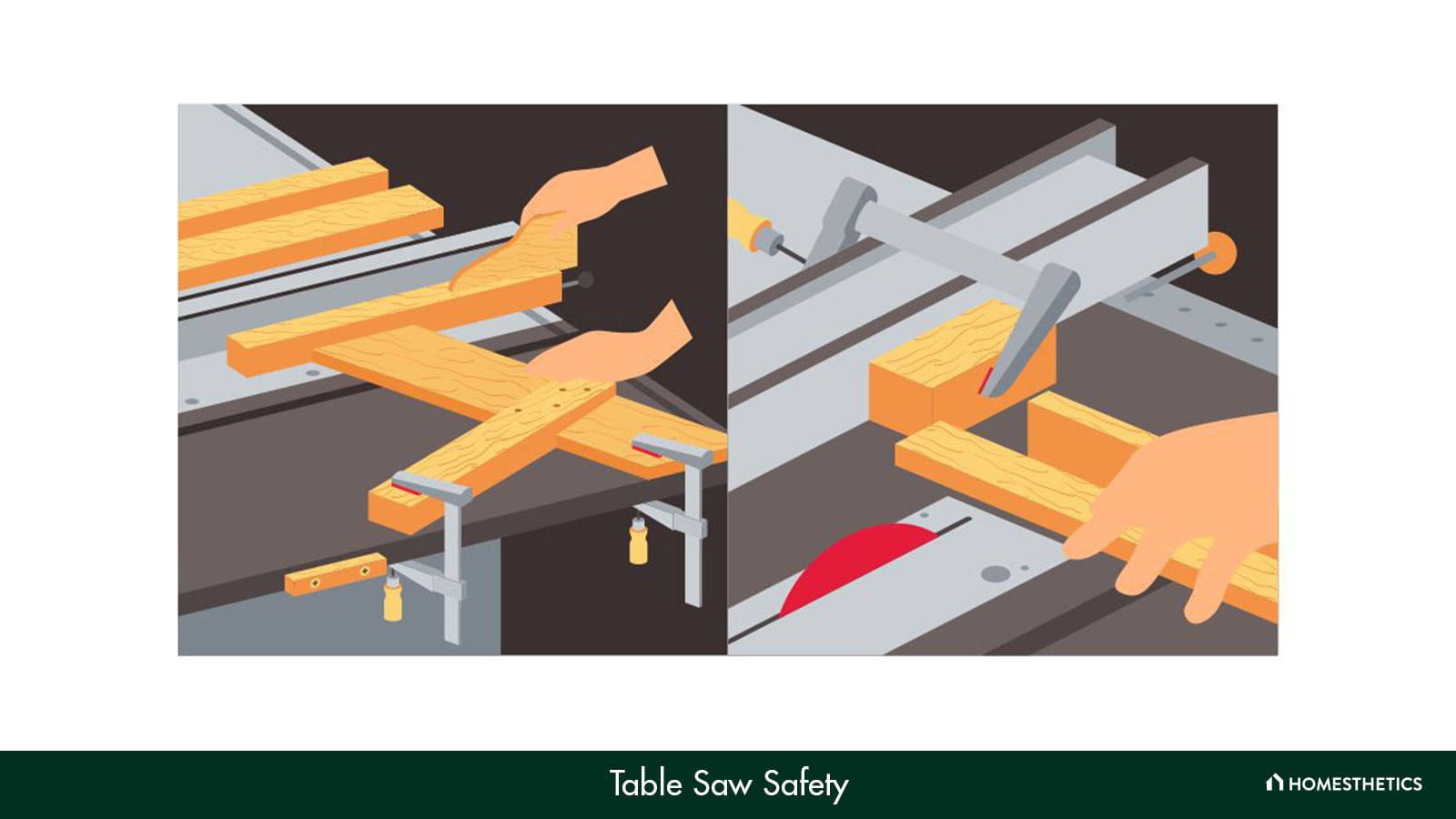
The chances of accidents are high if proper safety rules and precautions are not followed when using table saws. So, we’ve decided to cover the important table saw safety rules and guidelines in this article for your benefit.
Now, the name "table saw" creates a clear picture of what the tool is: a table with a saw on it.
Typically, table saws, like the contractor saws, include an electric motor-powered circular saw blade that is mounted on a mandril or arbor. The blade sits in the middle of the table, with a fraction of it peeking above the table for cutting wood or other material.
Despite being indispensable tools in woodworking, table saws pose significant safety risks when used incorrectly. These risks include kickback, incorrect blade usage, removing protective features like blade guards, and more.
Kickback happens when the material being cut is forced back toward the operator at high speed.
Other dangers associated with incorrect table saw usage include poor material support and inadequate training. Not providing enough support to the workpiece can cause it to bind or tip, while poor training can result in incorrect techniques that can cause accidents.
According to a recent study, more than 30,000 table saw injuries occur every year in the US, resulting in around ten amputations daily. As such, it becomes all the more important to follow table saw safety rules and regulations to minimize such risks.
Safety Warning: Safety regulations provided here are only meant to serve as guidelines. It is strongly recommended for users to go through the table saw manual, and lab safety rules, and undergo proper training before using such tools.
What is saw kickback in woodworking?
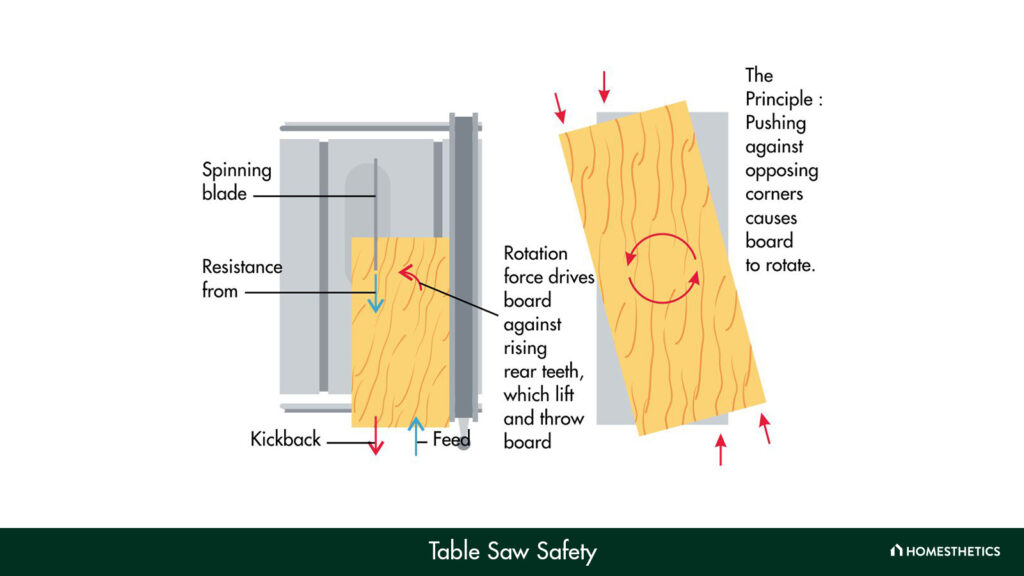
In woodworking, saw kickback refers to a situation when the stock is pushed back suddenly and forcefully. It can occur when using different types of saws, be it a table saw, chainsaw, or circular saw. Saw kickback can be highly dangerous and can result in extremely serious injuries.
It mainly occurs when the energy of the spinning blade gets transferred to the wooden piece being cut, which can happen due to various reasons. For instance, the rough lumber or stock being worked on can sometimes get trapped between the rip fence used for guiding the material and the side of the saw blade.
Additionally, if you feed the material into the saw very quickly, it can move off the worktable and ride up on the saw blade. This results in instability, increasing the chances of the material getting caught on the blade when it returns to the table. One of the most common reasons this happens is the use of a dull or incorrect blade.
Another factor that can result in kickback is setting the cutting blade very low. When the blade is set too low, more teeth come into contact with the material. This means the saw will require more power for cutting and may stall or slow down, resulting in kickback.
Based on our first-hand experience, there are a few ways by which you can prevent kickbacks when using table saws.
- Always use a sharp blade to prevent binding issues
- Use guides, jigs, or stands to support the workpiece properly
- Maintain a well-balanced and firm stance while cutting
- Avoid applying excessive force or overloading the saw
- Use safety equipment, such as safety goggles, push sticks, ear protection, etc.
- Be aware of the safety features of the saw, like riving knives and blade guards
- Follow the manufacturer's instructions and safety guidelines
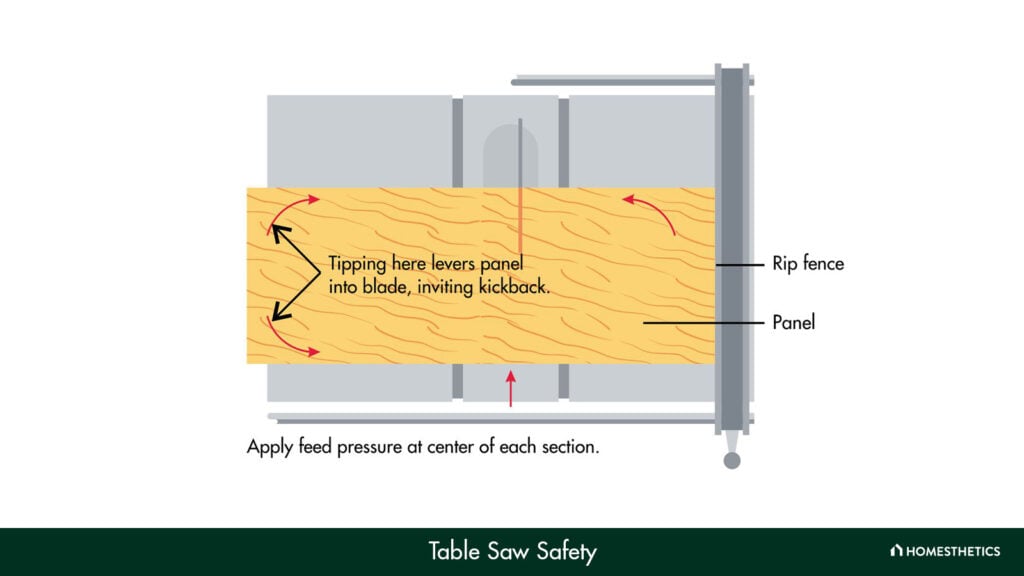
Table saw safety rules
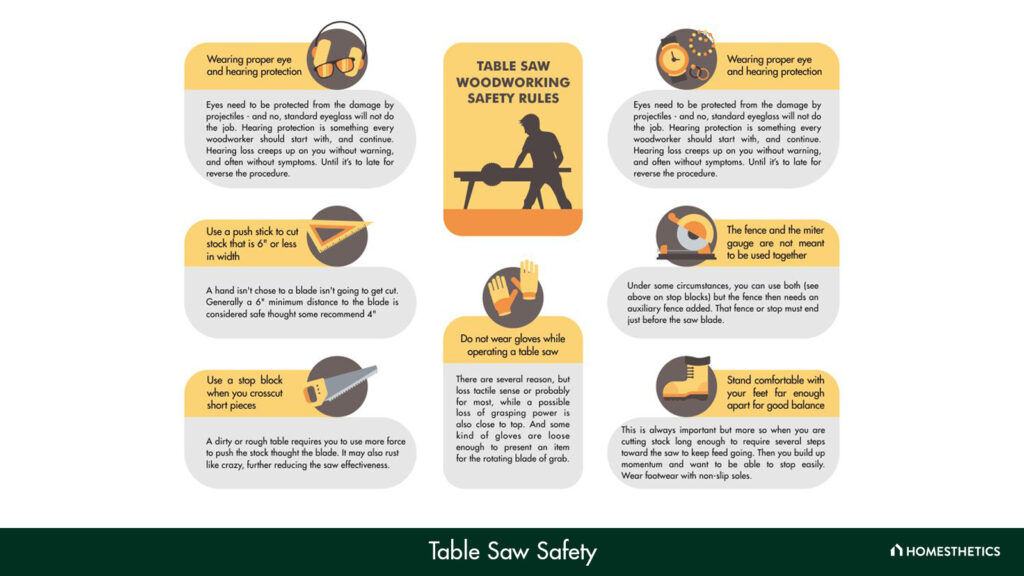
Awareness of various safety rules can help you avoid accidents and prevent woodworking injuries. Here, we've mentioned some of the most important safety rules that should be followed when using a table saw.
-
Go through the instruction manual
Always go through the instruction manual beforehand when using power tools like table saws. Instruction manuals explain the working of the tool and the proper method of using it to get desired results while ensuring safety. And drawing from experience, we suggest familiarizing yourself with the various parts of the table saw, its safety features, and how it can be adjusted for different tasks.
If you no longer have the manual, search for it online using the manufacturer's name and the model number of the saw.
-
Wear suitable clothing
Wearing the right clothing is an essential but often overlooked safety rule when using woodworking tools. Avoid wearing loose-fitting clothing, jewelry, and long sleeves, and if you have long hair, make sure to tie it back so it does not get in the way. Besides clothing, accessories like footwear need proper attention.
Based on our experience, the best options are closed-toe, non-slip shoes, which provide much better protection than flip-flops and sandals. You may want to wear gloves for hand protection, but avoid doing so as they can get trapped in the saw blade, like loose clothing and hair. They also reduce your sense of touch, which is vital when operating cutting tools.
You can check out online articles or woodworking books to learn about the best clothing and accessories that can be worn when using tools like a table saw.
-
Use personal protective equipment
When using a power tool like a regular or sawstop table saw, you should always use personal protection equipment (PPE). Such equipment can include safety glasses that protect wood chips and debris that can enter your eyes.
Additionally, earmuffs or earplugs help protect your ears from the noise such tools make, preventing hearing problems. A respirator is another piece of equipment that is crucial when using woodworking tools. Table saws and similar tools produce a considerable amount of sawdust, which includes microscopic particles that cannot be seen with the naked eye.
Exposure to these particles for an extended period can lead to various health issues, which can be prevented using a respirator.
-
Maintain a clean working area
In most cases, workshops and garages where woodworking projects are undertaken are cluttered and messy. But with various tools and pieces lying around, the chances of accidents become very high. So, you should always keep your working area clean by removing all unnecessary objects, materials, and tools.
Ensure the floor is free of tripping hazards, such as power cords and cables. Also, check that the workpiece you are working on has adequate space to exit. If the space is limited, consider moving the table saw next to a wall to free up some room. You can push the saw back to the middle of the room when it needs to be used.
-
Get rid of distractions
Distractions in your workshop can lead to serious accidents, especially when using tools like table saws. Some common distractions in workshops include TVs and phones. If your workshop has a TV, turn it on only when not using a power tool, such as during a break or when cleaning up.
Similarly, messages and calls on your phone can be highly distracting, so keeping it somewhere else instead of in your pocket is a good idea. The biggest distraction, however, tends to be people walking into the workshop.
Set rules for friends and family members so that they avoid entering the workshop when they hear the noise of the table saw.
-
Disconnect the power when changing blades
When changing the blades of your table saw, always disconnect the power so the tool does not turn on accidentally. If you turn off the tool without removing it from the power outlet, it may turn on if the switch is hit, leading to serious injury.
-
Ensure the blades are clean
Wood contains resin and sap, which can stick and accumulate on the blades of your table saw over time. When these substances cover the edge of the blades, they can affect their sharpness and adversely affect the performance of the blade.
Using a table saw with unclean blades means more feed pressure is needed, requiring greater force. In addition, such substances can burn the edges of the material you are working on, and resins can corrode the blades.
Frequent cleaning of the table saw blades can prevent these problems, and this can be done using a cleaner and a stiff brush.
Tip
Consider using caustic oven cleaners containing sodium hydroxide as the primary ingredient to clean your saw blade.
-
Wax the fence and the table
As with the saw blade, resins can collect on the fence and the saw table, creating difficulties moving the workpiece across its surface. One of the most effective ways to deal with this problem is to apply wax to the surface of the work table. This helps reduce friction so that the material can move smoothly over it without requiring much effort.
Wax also prevents resins from accumulating on the surface and reduces the chances of oxidation. However, it is crucial to select wax that does not contain silicone because wooden surfaces do not acquire finishes and stains when silicone-based wax is used. Because of this, using automotive wax is not recommended.
-
Use roller stands or outfeed tables
The cut pieces of the workpiece fall on the ground while exiting from the back of the table saw. In the case of larger and heavier pieces, instability can occur and cause the entire material to shift. When this happens, the workpiece can catch on the saw blade, causing kickback.
Roller stands and outfeed tables can prevent this from happening by providing support to the material, reducing the chances of kickback.
-
Allow the blade to stop
For obvious reasons, avoid putting your hand or body near the spinning blade until it stops. People often turn off their table saws and immediately tend to move toward the workpiece to check it out, leading to accidents. Waiting until the blade stops spinning can help prevent injuries and avoid costly treatments.
Table saw uses
There are multiple ways in which a table saw works for making different types of cuts. These cuts can include:
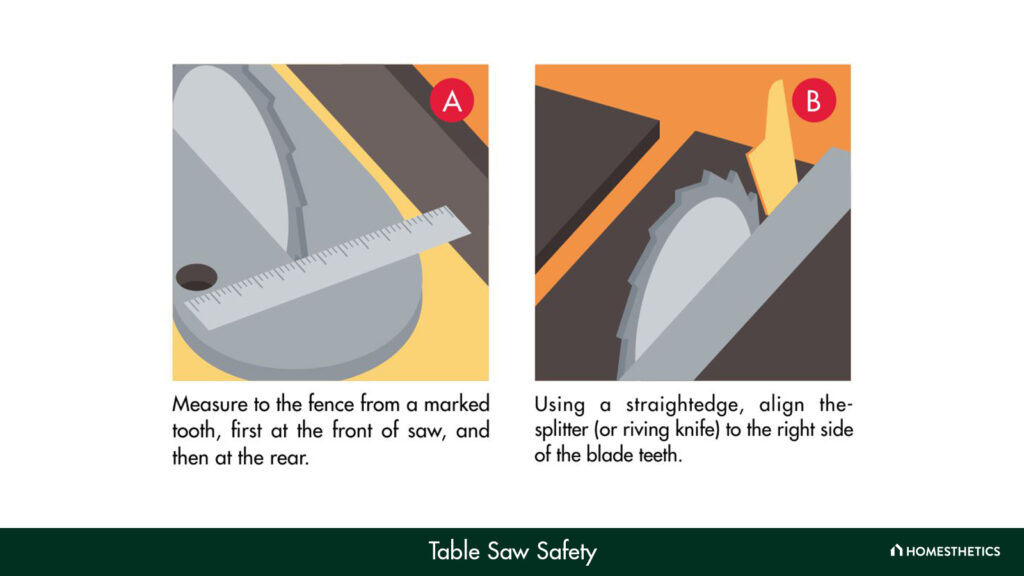
I. Ripping
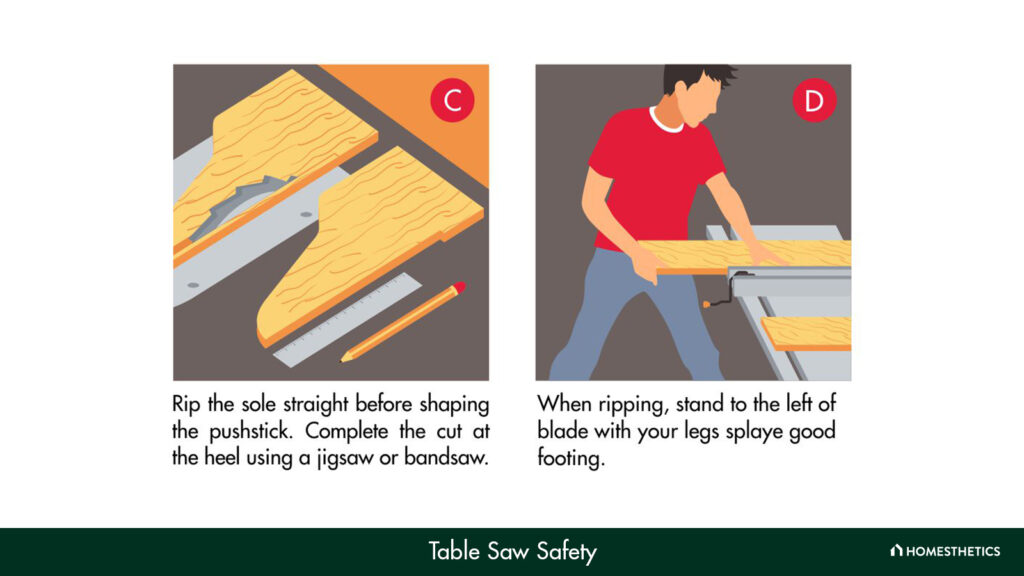
Ripping is the process of cutting a workpiece along its length, making it narrower. Table saws are well suited for creating rip cuts, and their rip capacity can be adjusted to accommodate different board widths.
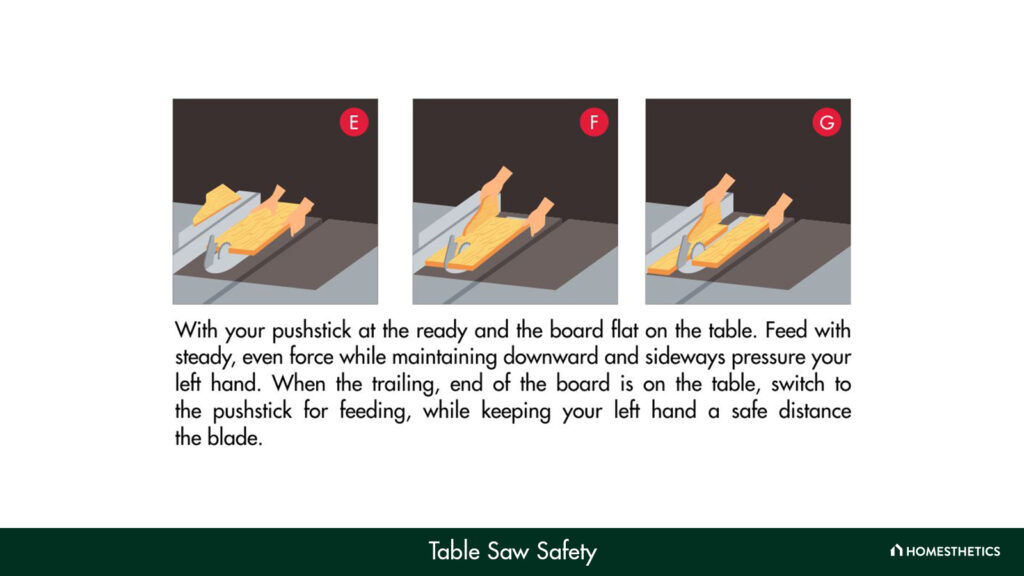
II. Crosscutting

The primary purpose of a table saw is to make rip cuts, but this tool is also commonly used for crosscutting. You can use a crosscut sled or miter gauge to make perpendicular cuts across the wood grain. The adjustable miter gauge of your table saw can be adjusted to the required angle for such purposes.
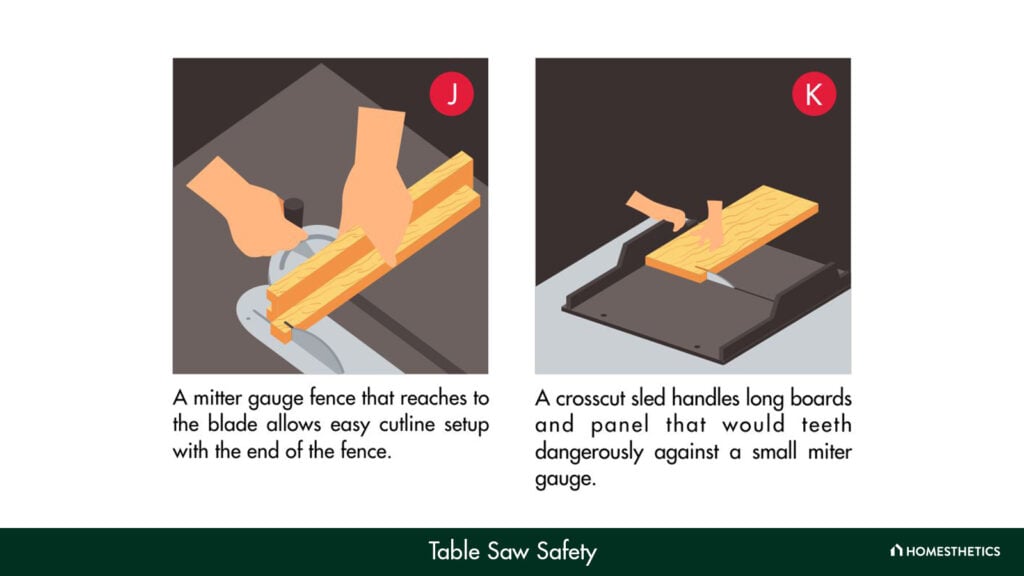 III. Bevel cuts
III. Bevel cuts
Many table saws allow you to adjust the angle of the blade and can be used for bevel cuts. These cuts are used to create chamfers, angled cuts, or beveled cuts across the thickness or width of the material.
This can be done by tilting the table saw to the angle needed and ensuring that the angle is accurate using an angle measure. Once the correct angle is obtained, turn on the saw to make the cuts.
IV. Grooves and rabbets
Joint cuts like grooves and rabbets can be created easily using a table saw. Both these cuts are in the form of narrow and long channels but are created differently. Grooves are created by making cuts near the center of the board, while rabbets are created by cutting near the edge.
Our findings show that these cuts can be quite dangerous since the riving knife and the blade guard need to be removed. So, make sure to follow the safety tips mentioned above.
V. Cutting joints
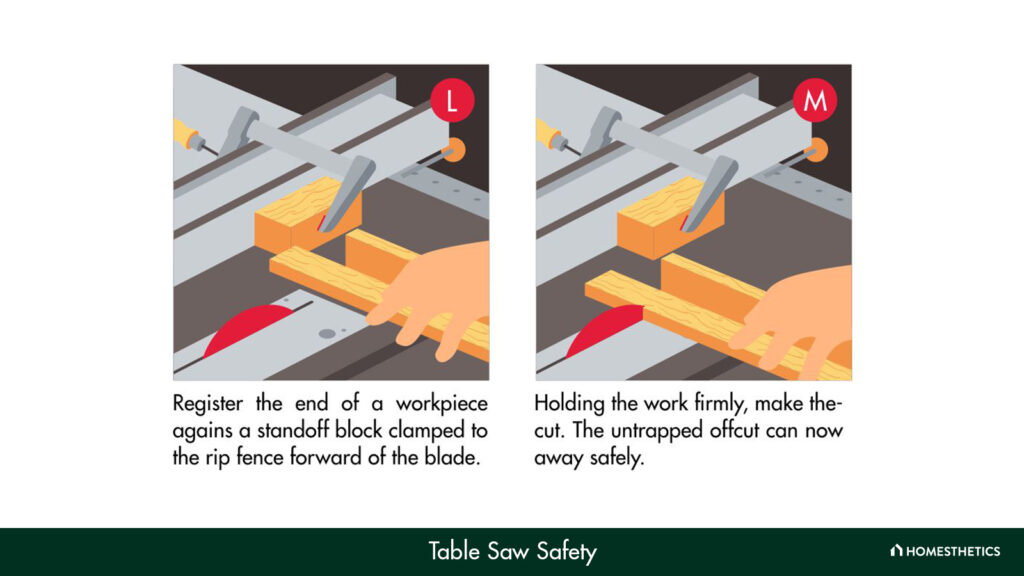
Table saws can be used to create different types of cutting joints besides grooves and rabbets. Again, some of these joint cuts require blade guard and riving knife removal, so following table saw safety rules is important to avoid serious injury.
The most common joint cuts created using a table saw include lap cuts, tenon cuts, dado cuts, dovetail cuts, reinforced miter cuts, and finger cuts.

VI. Kerfing
Kerfing is the process of removing sections of a board by making cuts on both sides of the board. This also separates the strip while providing flexibility to the wood so that even the thickest boards can get a curve. The resulting curve is tighter when the spaces between the cuts are smaller.
Should I use the fence and miter gauge together when using a table saw?
You should not use the fence and miter gauge together when using a table saw as doing so can cause pinching of the material, causing kickback, so only use one of them at a time.
Why should I not cut the material freehand when using a table saw?
You should not cut the material freehand when using a table saw. Freehand cutting means the workpiece cannot be steadied and can easily catch on the blade. So, it is better to use accessories like a sled, miter gauge, or rip fence.
What is the purpose of a push block?
The purpose of a push block is to help guide the workpiece during the cutting process while helping protect your hands. It offers more control than push sticks and does not create a pivot point that can result in accidents.
When used correctly with proper safety precautions, table saws can provide results that few other tools can match in woodworking. However, the large number of accidents and injuries resulting from incorrect use is a testament to the fact that many users ignore the safety rules that should be followed.
While adhering to these rules and guidelines may appear tedious, it can help you avoid accidents and the resulting medical expenses. Moreover, by adopting the right practices, such as undergoing proper training, you can get better results when working on various woodworking projects.
So, make sure to always go through the instructions and warnings provided by the manufacturer of your table saw, familiarize yourself with the tool, and utilize the safety features provided.
